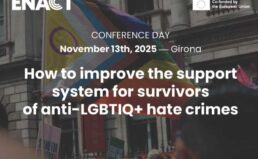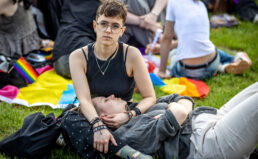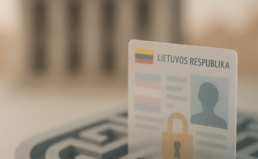Intersex Awareness Day commemorates what I call ‘intersex Stonewall.’
On 26 October 1996, two intersex activists were removed from the American Academy of Pediatrics Conference in Boston.
They tried to address the conference to challenge the treatment of intersex children, which still includes surgeries and other unnecessary and irreversible intervention to ‘normalize’ their genitals.
That was a defining moment in the intersex human rights movement. It’s when intersex activists clearly said enough is enough.
Intersex people are born with any of several variations in sex characteristics including chromosomes, gonads, sex hormones, or genitals that, according to the UN Office of the High Commissioner for Human Rights, ‘do not fit the typical definitions for male or female bodies.’
26 October is Intersex Awareness Day
It’s the day we as an intersex community conduct events across the globe to raise awareness of people with intersex variations. We have the aim of ending the shame and secrecy intersex people experience, and the unwanted medical intervention inflicted on intersex children without their consent and for no medical need.
‘We call for the immediate prohibition as a criminal act of deferrable medical interventions, including surgical and hormonal interventions, that alter the sex characteristics of infants and children without personal consent.’
This year it is a very special Intersex Awareness Day.
In Australia, we have events taking place across a number of states and territories, and the Parliamentary Friends of LGBTI people hosted a forum at Parliament House in Canberra last week.
That was the first federal Parliamentary Forum hearing from intersex activists. Speakers included members from Organisation Intersex International (OII Australia) and the Androgen Insensitivity Syndrome (AIS) Support Group Australia.
The feedback from Senators and Members of Parliament was very positive. The forum might even become an annual event.
Our events include public talks, screenings of intersex documentaries, and even smaller events with organizations keen to learn more about intersex people and our personal experiences.
Importantly, they give us the opportunity to speak with legislators about the changes we seek to protect intersex children and support the work we do as intersex organizations run by and for intersex people.
This year, Brisbane City Council will also light up the Story and Victoria Bridges in purple and yellow on the night of 25 October to commemorate the occasion.
‘Sex and gender binaries are upheld by structural violence’
All these events come after a very busy time for intersex activists in Australia.
Early in the year, intersex activists from Australia and New Zealand held a gathering in Sydney and formulated the Darlington Statement – a detailed joint consensus statement articulating who intersex people are, what issues we face, and how we want those issues addressed.
The statement said: ‘As with race or religion, sex/gender should not be a legal category on birth certificates or identification documents for anybody.’
It calls for easily accessible documents and a ‘simple administrative procedure’ for correcting sex/gender in a legal sphere.
It also states: ‘We call for effective legislative protection from discrimination and harmful practices on grounds of sex characteristics.’
Find out more about the Darlington Statement.




